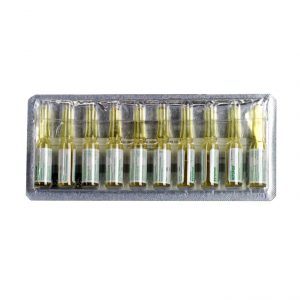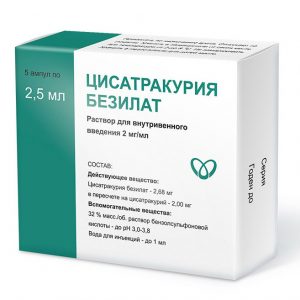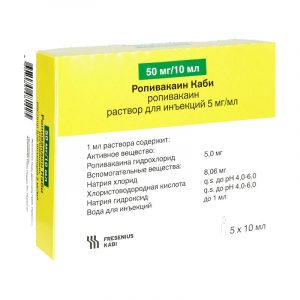Description
Pharmacological action
Drotaverinum is a derivative of isoquinoline, similar in chemical structure and pharmacological properties to papaverine, but with a stronger and longer lasting effect. It has a powerful antispasmodic effect on smooth muscle due to inhibition of the PDE enzyme. The PDE enzyme is necessary for the hydrolysis of cAMP to AMP. Inhibition of PDE leads to an increase in cAMP concentration, which triggers the following cascade reaction: high cAMP concentrations activate cAMP-dependent phosphorylation of myosin light chain kinase (MLC). Phosphorylation of MLCK leads to a decrease in its affinity for the Ca2 + -calmodulin complex, as a result of which the inactivated form of MLCK supports muscle relaxation. In addition, cAMP affects the cytosolic concentration of Ca2 + ion due to the stimulation of Ca2 + transport to extracellular space and sarcoplasmic reticulum. This effect of drotaverine through cAMP lowering the concentration of Ca2 + ion explains the antagonistic effect of drotaverine in relation to Ca2 +.
In vitro, drotaverine inhibits PDE4 isoenzyme without inhibiting PDE3 and PDE5 isoenzymes. Therefore, the effectiveness of drotaverine depends on the concentration of PDE4 in the tissues (the content of PDE4 in different tissues varies). PDE4 is most important for suppressing contractile activity of smooth muscles, and therefore selective inhibition of PDE4 may be useful for the treatment of hyperkinetic dyskinesias and various diseases accompanied by spastic gastrointestinal tract.
The hydrolysis of cAMP in the myocardium and vascular smooth muscle occurs mainly with the help of the PDE3 isoenzyme, which explains the fact that with high antispasmodic activity, drotaverine has no serious side effects from the heart and blood vessels and pronounced effects on the cardiovascular system.
Drotaverinum is effective for spasms of smooth muscles of both neurogenic and muscular origin. Regardless of the type of autonomic innervation, drotaverin relaxes the smooth muscles of the digestive tract, bile ducts, and the genitourinary system.
Due to its vasodilating effect, drotaverine improves blood circulation to tissues.
Indications for
smooth muscle spasms in diseases of the biliary tract: cholecystolithiasis, cholangiolithiasis, cholecystitis, pericholecystitis, cholangitis, papillitis
smooth muscle spasms of the urinary system: nephrolithiasis, pyrolithiasis, urinary cystitis, pyrrolithiasis, pyrolithiasis, urolithiasis, pyrolithiasis.
As adjuvant therapy:
for spasms of the smooth muscles of the gastrointestinal tract: peptic ulcer of the stomach and duodenum, gastritis, spasms of the cardia and pylorus, enteritis, colitis, spastic colitis with constipation and irritable bowel syndrome with flatulence
tension headaches
algodismenorea.
Contraindications
severe renal failure
severe hepatic failure
severe heart failure (decreased cardiac output)
breastfeeding period
childhood (no clinical studies in children), srdlkactosis, malignant lactose malignancy, lactose malignancy (due to the presence of lactose in the composition of the tablets)
hypersensitivity to drotaverine and / or auxiliary components the drug.
With caution, use the drug for arterial hypotension, during pregnancy.
Special instructions
Increased caution is required when using the drug in patients with hypotension.
Each tablet of No-spa ® Fort contains 104 mg of lactose. When taken according to the recommended dosage regimen, up to 156 mg of lactose (1.5 tablets of No-shpa ® forte) may be delivered with each dose, which can cause patients suffering from lactose intolerance, gastrointestinal disorders. This form of the drug is unacceptable for patients with lactase deficiency, galactosemia or glucose / galactose malabsorption syndrome.
Effect on the ability to drive vehicles and control mechanisms
When taken orally in therapeutic doses, drotaverin does not affect the ability to drive vehicles and perform work that requires an increased concentration of attention.
In the event of any adverse reactions, the issue of driving a transport and working with mechanisms requires individual consideration. In case of dizziness after taking the drug, the patient should avoid engaging in potentially hazardous activities, such as driving vehicles and working with machinery.
Composition
1 tab. contains drotaverine hydrochloride 80 mg
Excipients: magnesium stearate, talc, povidone, corn starch, lactose monohydrate.
Dosage and administration
The drug is prescribed orally.
Typically, the average daily dose is 120-240 mg in 2 3 doses.
Side effects of
The following side effects, which in clinical studies were regarded as at least possibly related to drotaverine, are given in accordance with the following frequency of occurrence: very often ( 1/10), often ( 1/100, <1/10) rarely ( 1/1000, <1/100) sometimes ( 1/10 000, <1/1000) very rarely, including individual messages (<1/10 000) the frequency is unknown (according to the available frequency occurrence is impossible to determine).
From the nervous system: sometimes – headache, dizziness, insomnia.
From the cardiovascular system: sometimes – palpitations, decreased blood pressure.
From the digestive system: sometimes nausea, constipation.
From the side of the immune system: sometimes allergic reactions (itching, rash, urticaria, angioedema).
Overdose
An overdose of drotaverine has been associated with heart rhythm and conduction disturbances, including complete blockade of the bundle branch block and cardiac arrest, which can be fatal.
Treatment: in case of overdose, patients should be under medical supervision. If necessary, treatment should be symptomatic and aimed at maintaining the basic functions of the body.
Storage conditions
The drug should be stored out of the reach of children at a temperature not exceeding 25 ° C.
lekarstvennaja form
tablets




